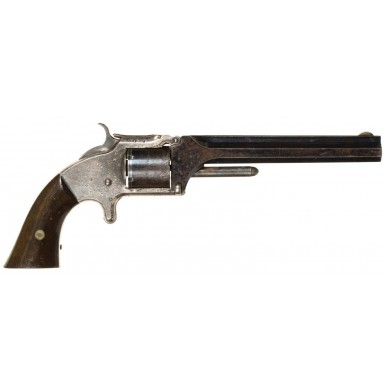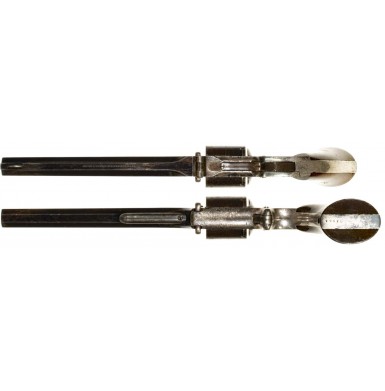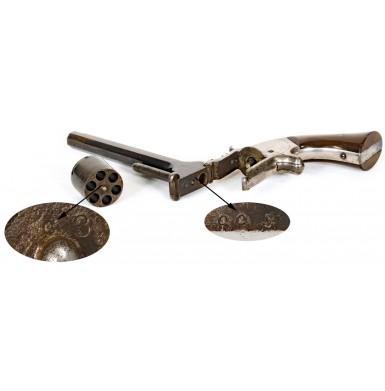Kittredge & Co Marked Half-Plate Smith & Wesson No 2 Army Revolver
- Product Code: FHG-2105-SOLD
- Availability: Out Of Stock
-
$1.00
This is a VERY FINE example of one of the most popular metallic cartridge revolvers of the American Civil War period; the Smith & Wesson No 2 Old Army. The “Number 2” revolver was a six shot, .32 caliber single action revolver that fired a .32 caliber rimfire cartridge. The revolver was introduced in 1861 and remained in production until 1874. During that time some 77,155 of the revolvers were manufactured. Those pistols under serial number 35,731 were produced prior to May 1, 1865 and are considered revolvers that may have seen Civil War use.
The pistol used Smith & Wesson’s “tip up” action design that they introduced with the .22 caliber No 1 Revolver. To load or unload the pistol the release at the bottom of the frame was pushed, allowing the barrel to be tipped up and the cylinder removed. Pushing the chambers over the fixed ejector rod under the barrel removed the empty cartridges, allowing fresh cartridges to be dropped into the chambers. These guns were very popular personal side arms for soldiers and officers on both sides during the conflict. Smith & Wesson No 2 pistols were known to be owned and used by such diverse and historic figures such as Brevet General George Armstrong Custer and the infamous lawman “Wild Bill” Hickok. Period images regularly show soldiers with an “Old Army” revolver stuck in their belt. From the standpoint of size, weight and cartridge power, the Smith & Wesson No 2 was probably one of the most practical pistols for company grade officers to carry in the field. It was lighter and easier to deal with than a Colt Navy or Colt Army percussion revolver and was more powerful than the popular .22 rimfire pocket pistols of the era. The No 2 was typically produced with a blued finish, with a color case hardened hammer and ejector rod. Standard grips were varnished rosewood. However, special finishes and grips were available via special order. Options included nickel plating and a unique “half-plate” finish, with a silver plated frame and a blued cylinder and barrel. Exotic grip materials like mother of pearl and ivory were available on special order as well.
This Smith & Wesson No 2 is serial number 34,564, which places its production in the spring of 1865, right at the end of the American Civil War. The serial numbers for Smith & Wesson No 2 revolvers produced in 1865 run from 29,359 through 48,475, with a production of 19,116 No 2 revolvers that year. The revolver is also one of the scarce “half-plate” revolvers with a silver plated frame and blued barrel and cylinder. The revolver is also marked with a scarce and desirable retailer mark, that of Benjamin Kittredge and Company of Cincinnati, Ohio. Kittredge was a major sporting goods and firearms retailer located in Cincinnati, who not only sold at retail to the public by had institutional customers like the State of Kentucky and acted as a distributor for major firearms manufacturers like Colt and Smith & Wesson, reselling the arms to smaller retailers further west. In 1862, the firm ordered 2,600 No 2 Army revolvers from Smith & Wesson and resold 733 of them to the state of Kentucky. The deliveries to the state were in six lots, four in August of 1862, totaling 631 guns, with another 100 delivered on September 8, 1862 and a final 2 delivered on May 11, 1863. These guns, like many other Kittredge retailed guns were marked with the firm’s name. In this case, this revolver is clearly stamped in two lines on the left side of the barrel web, forward of the cylinder:
B. KITTREDGE & CO
CIN. O.
The Kittredge name is stamped in an arc, encompassing the “CIN. O.” which closes the half-circle made by the stamp. The finish and shipping destination of the revolver is confirmed by a letter from Smith & Wesson historian Roy Jinks. According to surviving factory records, this revolver was part of a total of 75 No 2 Army revolvers that were ordered by B. Kittredge & Co. All of the guns in the order were “half plate” silver and blue finished with varnished rosewood grips and 6” barrels. The records indicate that the revolvers were probably shipped on April 29, 1865; 20 days after the Confederate Army of Northern Virginia surrendered at Appomattox Court House, VA and 3 days after the official surrender of the Army of Tennessee near Durham Station, NC.
As noted, the revolver is serial number 34564. The serial number is very clearly stamped in the bottom of the grip frame and is also stamped inside of the right grip panel. The gun is mechanically excellent with a crisp action and a very tight lock up. The gun times and indexes exactly as it should. Typically, these “tip up” revolvers are found with excessive play in the hinge between the barrel and frame and they tend to wiggle. This one is nice and tight. The top of the barrel rib is clearly marked in a single line with the typical Smith & Wesson information:
Smith & Wesson Springfield. MASS.
The cylinder is clearly marked around its center:
PATENTED APRIL 3, 1855. JULY 5, 1859 & DEC. 18, 1860
The April 3, 1855 date referred to the Rollin White patent for the bored through cylinder. The July 5thdate referred to Smith & Wesson’s patent for an improvement to the frame design of their earlier No 1 revolvers, which allowed larger caliber rimfire ammunition to be used more reliably, and the December 18thpatent described in detail the revolver that would become known as the “No. 2”.
This gun has the highly desirable 6” ribbed barrel, considered the favorite barrel length for those soldiers who carried an “Old Army” in the field. The pistols produced with 5” barrels are the most common, and the 6” guns are the second most often encountered. The gun has the matching assembly number CC3 stamped on the left grip frame under the grip panel, on the face of the cylinder and on face of the barrel frame below the forcing cone. As noted, the gun is in about VERY FINE condition. It retains about 90%+ of the silver “half-plate” finish on the frame, with some bubbling, flaking and loss. The silver has a nicely tarnished tone, with the greatest amount of loss on the backstrap and grip strap where the revolver was handled the most.
The barrel of the revolver 50%+ of its original blued finish, with most of the vibrant bright blue in the protected areas, under the barrel and along the top angled flats that terminate at the rib. The blue on the cylinder has faded and worn leaving only about 20%+ of the finish but has developed a very pleasing bluish-gray patina that blends well with the finish remaining on the balance of the pistol. The hammer retains about 20% of its case coloring, most of which has faded and dulled to a smoky gray color. The metal of the pistol is mostly smooth, with some scattered light pinpricking present, here and there. There is some light pitting present that is primarily confined to the face and sides of the cylinder at the leading edges, on the sides of the frame forward of the cylinder and inside the frame and on the rear face of the barrel assembly. There are also some scattered areas of light surface oxidation and roughness present on the cylinder. The bore of the pistol is in about VERY GOOD condition. The bore is moderately oxidized and shows scattered light to moderate pitting along its entire length. However, the rifling remains clear and crisp. The gun retains sharp edges along the octagonal barrel, and the original German silver sight blade remains in place at the end of the barrel. The rosewood grips are original to the gun and are in about VERY FINE condition as well. They retain about 80%+ of their original varnish. The grips are free of any breaks, cracks or repairs. The grips do show some minor bumps, dings and handling, marks, with some edge wear but remain extremely crisp overall. They are very attractive, matching the revolver’s condition perfectly.
Overall this is a really great example of one of the most popular Civil War era side arms. The gun is 100% complete, correct and original, and it functions perfectly. It has the scarce and desirable factory “half-plate” finish that is confirmed by a factory letter and also bears the scarce desirable retailer mark of B. Kittredge & Co. This gun represented the first truly successful, mass-produced American cartridge pistol that was chambered in a reliable caliber that could actually be called an “effective” combat or self-defense cartridge. All previously successful metallic American cartridge revolvers had been chambered in the anemic .22 RF short or in some strange patent cartridge that was expensive, unreliable and difficult to obtain. The Smith & Wesson No 2 was a breakthrough revolver in these respects and is one that no Civil War handgun collection is complete without. This is a really nice example with some rare and desirable features that would be equally at home as an addition to your advanced collection of Civil War era secondary martial revolvers or 19thcentury Smith & Wesson handguns. The original Smith & Wesson letter that is shown with the revolver will be delivered with the gun to the new owner.
SOLD
Tags: Kittredge, &, Co, Marked, Half-Plate, Smith, &, Wesson, No, 2, Army, Revolver














